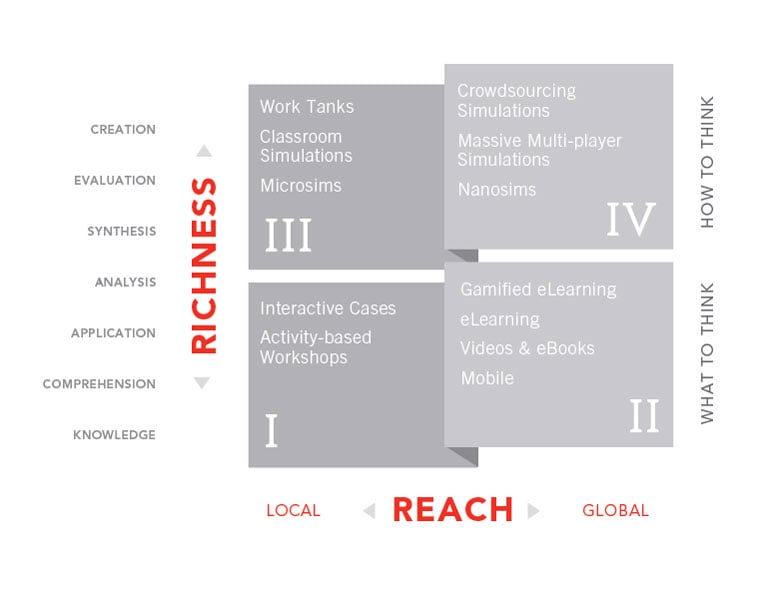Most leadership development training programs and technologies are based on the premise that knowledge is power. Training focuses on transmitting information from teacher to student with the idea that the mere accumulation of knowledge will equip the student to function effectively in the world.
“Sage-on-the-stage” workshops and basic e learning courses reinforce a model built around filling students’ minds with information. However, a closer look at how the brain is wired, how adults learn, and what creates sustainable change reveals that the mainstream models are missing the mark.
Traditional leadership development training programs are designed to improve performance in a specific area of practice. Students go to history class to memorize dates, people, and events. In math, they memorize rules and theorems. To become accountants, students accumulate a vast amount of information during the course of school. When they enter the workforce, this foundation is expanded through specific training in organizational rules, processes, regulations, and industry-specific financial terms.
There are more than fifty different methodologies for designing corporate leadership training programs and interventions. Though the steps, tools, and duration of the methodologies vary, most produce training that focuses on the bottom three levels of Bloom’s Taxonomy: knowledge, comprehension, and application.
Knowledge defines an individual’s ability to recall data (e.g., reciting a definition of a term). Comprehension means the individual can take the definition and restate it using his own words. Achieving the Application level means the individual can apply the definition to a task.
The next three levels—synthesis, evaluation, and creation—refer to his ability to draw correlations from disparate data points, assess outcomes as a result of some decision or action, and develop new courses of action, respectively.
The bottom three levels can be equated to teaching people what to think. The top three levels are focused on teaching people how to think.
At The Regis Company, we have developed the Learning Impact Tool shown below to categorize the different types of training solutions in relation to their Richness and Reach.
Richness is defined as the impact of the learning. Along the Richness axis, you will see the levels of Bloom’s Taxonomy (knowledge, comprehension, application, analysis, synthesis, evaluation, and creation). The higher on the Richness axis a solution falls, the greater the depth of learning. The Reach axis describes the number of people who participate in the training. The further to the right a solution falls, the greater the number of participants.

Quadrant I, in the lower left, depicts learning solutions with relatively low levels of richness (focused almost exclusively on information that the student needs to know) and limited reach. Workshops, even those that incorporate role-plays or activities, fall in the spectrum of Quadrant I.
Quadrant II, in the lower right corner, shows solutions that build a foundation of knowledge through online media—thus reaching a larger number of employees. E-learning and various social media/Web 2.0/3.0 options make up this quadrant.
These what-to-think quadrants focus on providing employees with knowledge and comprehension. Courses might help them recall data and information, or learn facts, processes, and procedures.
The how-to-think quadrants, III and IV, focus on the higher cognitive skills, such as analysis, synthesis, evaluation, and creation. As Bloom wisely pointed out, the higher-order thinking skills are personally and organizationally more valuable in the long term, because they can be applied in a variety of situations and they prepare the learner for unexpected variations.
Quadrant III, in the upper left corner, represents learning solutions with relatively high levels of richness (experiences that challenge us to learn how to think) but limited reach, such as classroom-based business simulations or WorkTanks. A WorkTank combines learning with the actual production of a needed work product for the organization. For example, within a strategic alignment WorkTank, participants develop actual strategies and vet them by running various scenarios across different market conditions.
A Quadrant III microsim generally is a shorter business simulation that focuses on a few skills. It is often included in classroom activities or embedded within e learning modules to increase the richness and provide skill practices.
Quadrant IV, in the upper right corner, represents solutions that provide high levels of richness and reach through online technologies, such as massive multiple player simulation training. Quadrant IV–type business simulations are targeted at global organizations requiring deep learning and global reach. These simulations incorporate the tools necessary for teams to collaborate in solving complex problems.
While Quadrants III and IV offer more effective how-to- think learning experiences, most of today’s leadership development training programs fall into Quadrants I and II. The impact of these programs is often measured by collecting “smile sheets” or “seat time.” The number of people touched is a primary measure of success for this type of learning—there is plenty of content, but actual behavioral impact is minimal.
While Quadrant I and II-type training certainly fill a need for basic dissemination of information, The Regis Company maintains its focus on helping teams solve the most complex problems with simulation training that provide the highest levels of richness and reach.